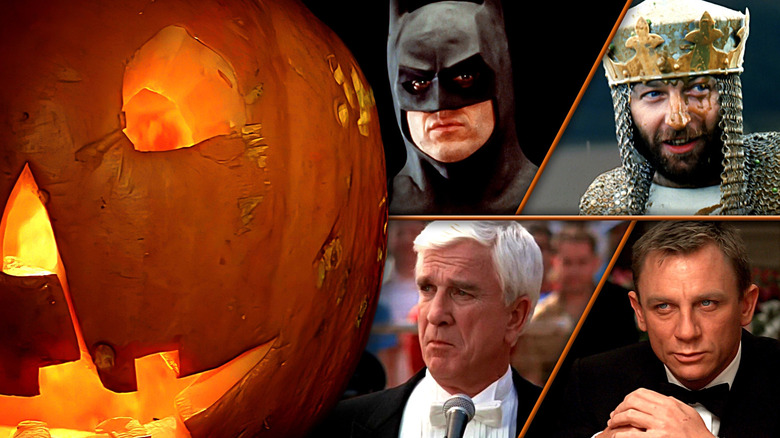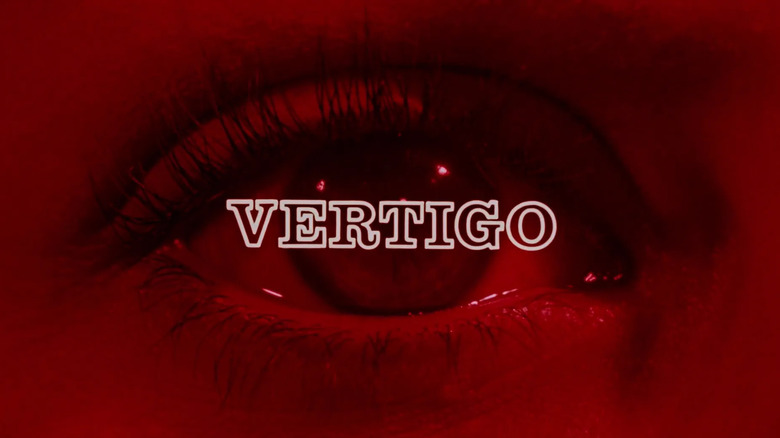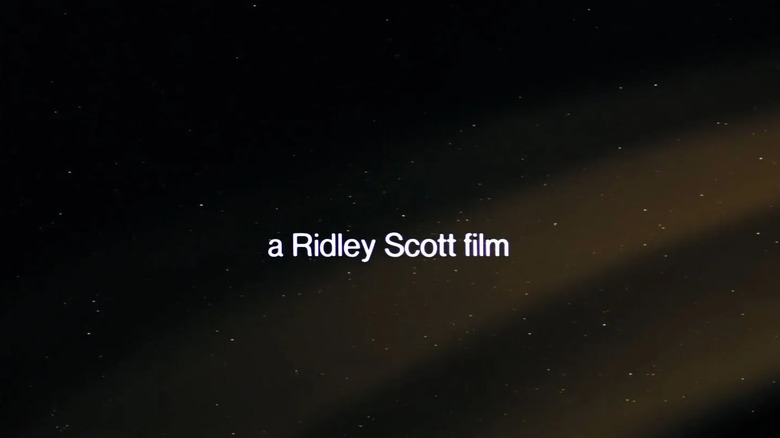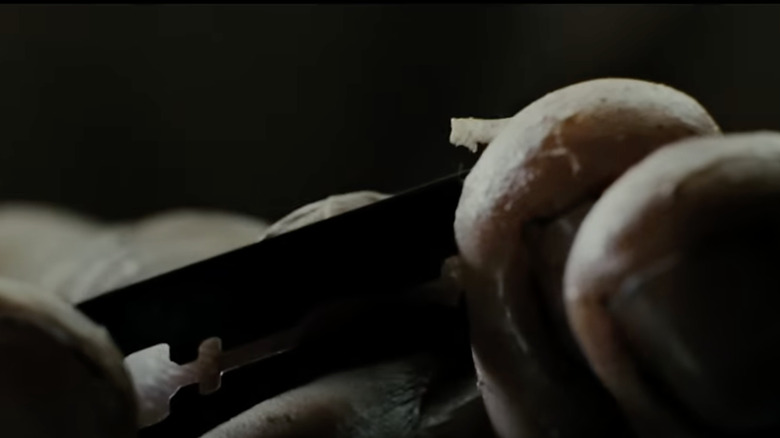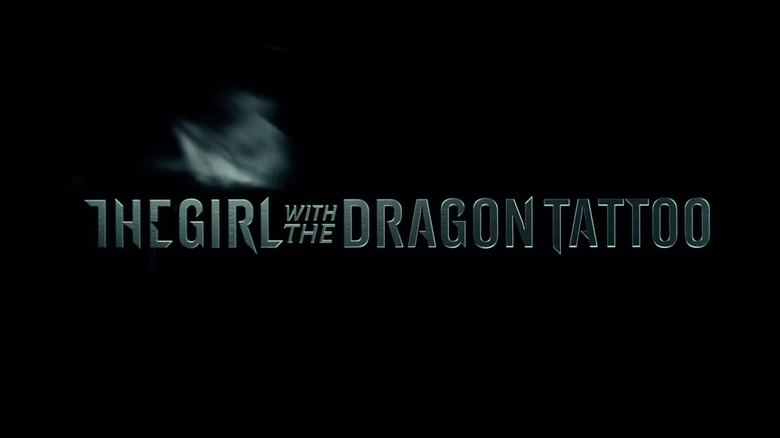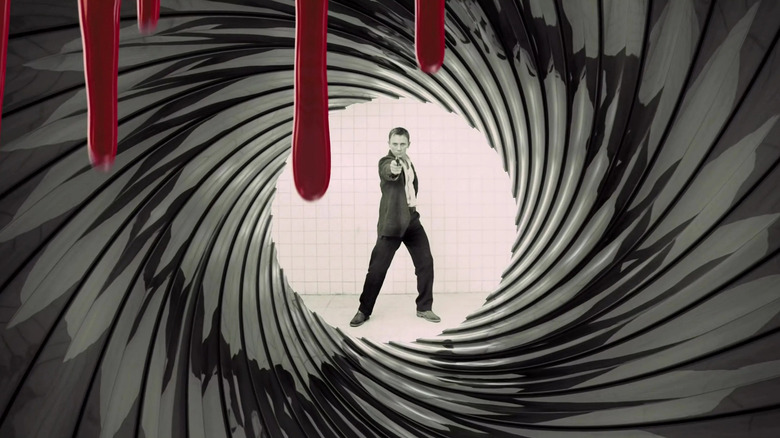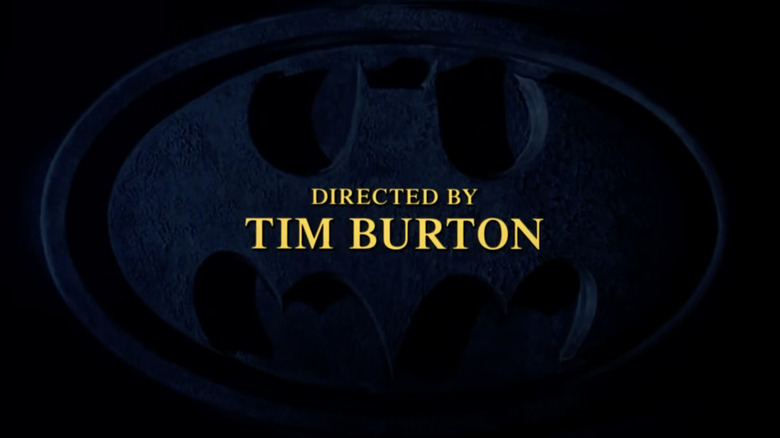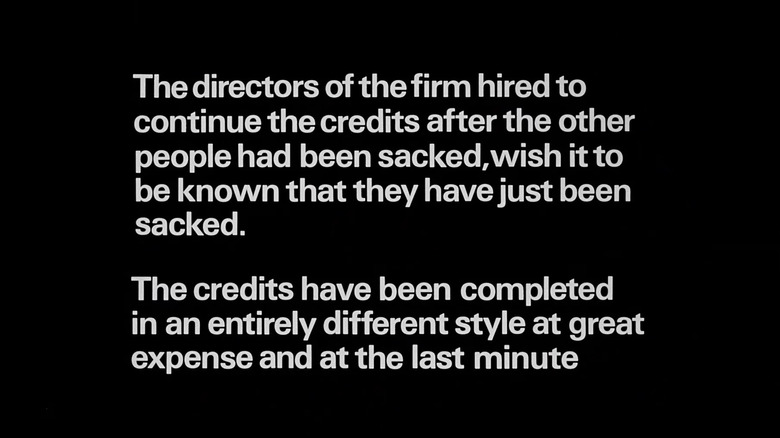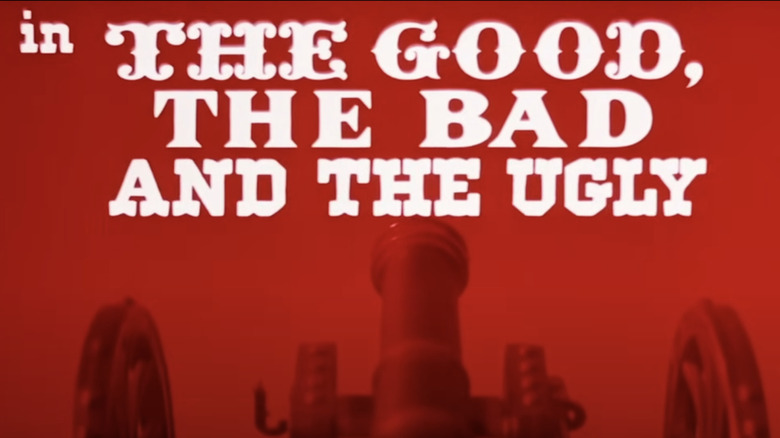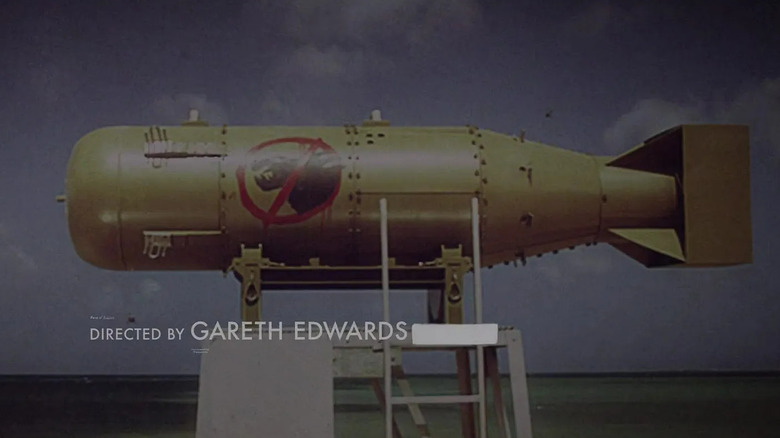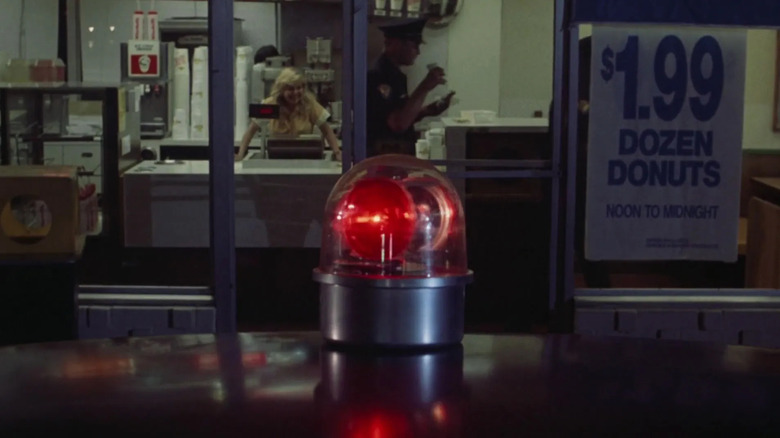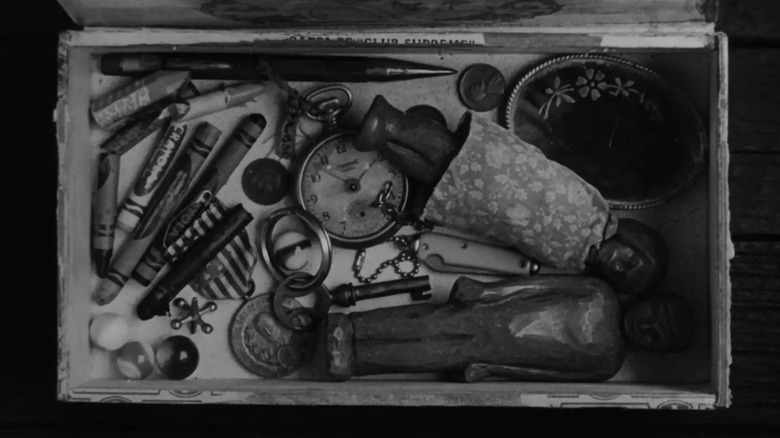15 Best Movie Opening Title Sequences Of All Time
Opening title sequences are dying a slow death. Though they may have been replaced by the closing credits sequence (thanks Marvel), even those are a rare treat. Filmmakers simply don't deliver a 2.5-minute opening title sequence that often, perhaps suspecting today's viewers don't have the patience. Blame our micro-second attention spans, somewhere between fruit flies and goldfish. Or maybe — considering every other movie is a 2.5-plus-hour epic — filmmakers simply don't want to spend one second on scenes they didn't shoot. Whatever the reason, it's a darn shame, as great opening title sequences have often contributed greatly to cinematic masterpieces. So we're going to celebrate the best!
Firstly, we're saluting opening title sequences, not opening credits scenes. What's the distinction? While a title sequence is separate from the movie itself, whjile a scene occurs within the movie (e.g. "Touch of Evil," "Deadpool"). Secondly, this is not a ranking. Honestly, we're not even sure how to rank title sequences ("I prefer the circle over the square"). Rather, it's a celebration of opening title sequences that were both artistic achievements and successfully set the scene for the movie we were about to watch.
There have been many great opening title sequences in the history of cinema, but these 15 are the best movie opening title sequences of all time!
Halloween
When you have John Carpenter's absolutely chilling, nerve-racking "Halloween" theme playing in the background, the opening title sequence of a movie can literally just be a jack o'lantern. That's just what Carpenter did, showing a charming but somehow menacing pumpkin with an unsettlingly happy smile while his very own creepy melody prepped us for the horrors about to follow. Carpenter was on a tight budget, and an even tighter deadline, forcing him to also write the film's signature, unnerving score, which he amazingly did in just three days. Guess that brings a whole new meaning to "Carpenter Shop," right? Sorry, not sorry.
The opening title sequence was so successful that it was repeated throughout the "Halloween" franchise (well, at least the good ones), while the trademark melody became Michael Myers' de facto theme song. As one of the first (and in our opinion, the best) slasher villains, Myers was always destined for greatness. But it was thanks to this title sequence that he stabbed a place in our hearts as one of the greatest horror movie monsters.
Vertigo
In 1958, Alfred Hitchcock made the movie many consider to be his masterpiece, and some even say is the greatest movie of all time: "Vertigo." The slow-burn suspense thriller starring James "Jimmy" Stewart tells the story of a retired detective who left his policing career due to paralyzing acrophobia, which is so severe that he can't even stand on furniture. In typical Hitchcock fashion, the movie plays on our expectations and our emotions, as the tragic man with a paralyzing fear of heights slowly falls into obsession and eventually madness, as he suffers the fallout of a doomed love.
American graphic designer (and the bar none the greatest opening credit designer ever) Saul Bass understood the assignment and developed an opening credit sequence that feels like we're falling. Into what, exactly? We're not sure, which is precisely the point. With Bernard Herrmann's haunting strings lulling us into submission, the opening credits feel like a dream — or maybe a nightmare. The perfect preparation for The Master of Suspense's magnum opus.
Alien
"In space, no one can hear you scream," cautioned the chilling warning plastered onto the poster and marketing materials for Ridley Scott's "Alien," which may be the greatest movie tagline of all time. How do you possibly follow that? Well, graphic designer Richard Greenberg took one look and said, "Hold my Aspen Beer," and produced an opening title sequence every bit as unnerving.
For some movies, "slow burn" is a polite way of saying "mind-numbingly boring," but "Alien" proves the power of restraint. Greenberg's title sequence establishes the film's icy tone, showing the vast emptiness (and ambivalence) of space as mysterious geometric shapes appear like ancient hieroglyphs. We're uncertain what we're seeing and why, until the shapes begin to form the film's title: "ALIEN."
While the "Alien" franchise would descend into the sublimely schlocky (and even the just plain dumb) the original remains a testament to temperance in filmmaking. Much like the movie itself, its opening credit sequence shows just how profoundly terrifying subtlety can be. Good thing nobody could hear us scream in space (or our living rooms).
Do The Right Thing
Spike Lee made two feature-length films before "Do The Right Thing," yet the 1989 drama still felt like a young auteur bursting onto the scene in a big way. The opening credits embody the same brash and audacious un-deniability of the film, as well as the filmmaker who made it. What starts with a smooth jazz saxophone over the film's title against a black title card switches to become what is essentially a music video.
For three dynamically disorienting minutes, we see quick cuts of a Harlem city block bathed in brightly colored lights as Rosie Perez dances to "Fight The Power" by Public Enemy. The opening scene speaks to the irony of inner-city life; buoyant and joyful one moment, stunningly harsh the next. Yet through it all is the singular vision of a director who was no longer just someone to watch but someone to take seriously. Like many great filmmakers, Spike Lee has had his ups and downs, but there's no denying "Do The Right Thing" remains the feather in his cap.
Psycho
Even those who have never seen Alfred Hitchcock's 1960 film are familiar with its most famous scene (and perhaps the most famous scene in movie history, period). We're talking about the infamous, controversial "shower scene," where Janet Leigh's Marion Crane (our protagonist up to that point) gets shockingly stabbed to death by meek motel proprietor Norman Bates (Anthony Perkins), dressed as his dead mother. It's a shame in some ways, because the movie is more than its most famous scene, starting with its exceptional opening title sequence.
Credit goes to graphic designer Saul Bass and composer Bernard Herrmann, as Bass' simple white lines do a dance with Herrmann's harsh strings, creating a striking two-minute tango of tension and suspense. The irony of this scene is that even while everything appears so impeccable — the angles of the lines are perfectly straight and the chords are perfectly played — the two work together to create an effect that still seems so ... off. The opening credits are not unlike Norman Bates himself, an otherwise put-together young man who, beneath the surface, is a roiling cauldron of chaos.
Se7en
"Se7en" remains one of cinema's most unsettling crime thrillers for many reasons, from its super-original premise, to the still-shocking ending. Yet while it's a timeless classic, in many ways "Se7en" still feels very mid-90s. This isn't a bad thing, as "Se7en" is a time capsule to a cinematic style and aesthetic that feels grungy, grim, and almost degenerate, which is embodied by its opening credits.
Kyle Cooper designed the groundbreaking sequence in a style foreshadowing analog horror. For two troubling minutes we see a series of extreme close-ups of developing photos, aggressive journaling, and gruesome imagery, including an unseen figure cutting his own fingertips. Though it started as a joke, Cooper's sequence is credited with revitalizing the art of the opening credits, which even in 1995 was disappearing. Adding to the sense of unease is the score. While Howard Shore ("The Lord of the Rings" trilogy, anyone?) scored "Se7en," the music over the opening credits is a remix of "Closer" by Nine Inch Nails. Like we said, very 90s yet still pitch perfect to this day.
The Girl With The Dragon Tattoo
If the opening credit sequence is living on life support, we have directors like David Fincher keeping it alive. We'll give "The Curious Case of Benjamin Button" and "The Social Network" a shoutout for honorable mention, and would do the same for"Alien 3," but Fincher disowned that movie. Sadly, we can't include every Fincher flick, so we have to show some love to "The Girl With The Dragon Tattoo."
"The Girl With The Dragon Tattoo" features the best James Bond opening titles not in a James Bond movie, and not just because it stars Daniel Craig. Designed by animation house Blue Studio and featuring a techno-pop remake of Led Zeppelin's "Immigrant Song," the credits show an inky black substance forming shapes relevant to the movie; dragon scales, wires, computers, and its stars, Craig and the dragon-tattooed girl herself, Rooney Mara. The black substance is revealed to be flammable, igniting the screen, and setting the stage for the combustible suspense thriller we're about to see.
Casino Royale
You expect to see certain things in a James Bond movie: beautiful cars, even more beautiful Bond girls, fancy gadgets, shaken-not-stirred martinis, Monty Norman's iconic theme, and, of course, killer opening credits. Rather than rank them all, we're selecting the one we believe stands above all others: "Casino Royale." Everybody has their favorites ("Live & Let Die," "Skyfall," "Diamonds Are Forever"), but we're placing our bets on the 2006 reboot that saved the cinematic spy series, which had gotten a little silly with 2002's "Die Another Day."
While that admittedly successful flick saw Bond racing a solar ray from space in an invisible car, "Casino Royale" promised a grimmer, grittier, more believable Bond. The opening credit scene the sets the stage. Following a black-and-white bathroom beatdown, the sequence starts with the iconic "James Bond shoots bad guy through gun barrel" imagery, followed by the journey of a photorealistic Daniel Craig through a game card-inspired world. It creates a fresh, but familiar theme that promises novelty and nostalgia. But perhaps the best part is the theme music, "You Know My Name," cowritten and performed by the late Chris Cornell, a perfectly inspired choice, a legendary rebel very much like Bond...James Bond.
Batman
Bat fans had every reason to be skeptical about "Batman." The Caped Crusader's first big screen outing since the kitschy Adam West flick in 1966 was directed by the guy behind "Pee Wee's Big Adventure," and starred "Mr. Mom." Sure, the studio stemmed the stans' ire, with a pic of Keaton in costume, plus a poster and trailer that promised a darker Dark Knight. Still, movie marketing doesn't always deliver the film that fans paid to see. Well, all of the fans' doubts that Burton fought against went by the wayside within the first two mintues.
The scene is epic in its simplicity. The Warner Bros. logo gives way to a blue-and-black tinted world as we descend into what appears to be a cave, with the chilling strings of Danny Elfman's brilliant "Batman March" guiding our way. By the time the strings give way to a gong as "Batman" envelops the screen, we are so there. We continue coursing through the "cave," uncertain where we are or where we're going until the very end. We have been inside the iconic Bat emblem this whole time. With an opening scene like this, it's easy to see why "Batman" broke all the records.
Monty Python and The Holy Grail
The trailblazing British comedy troupe Monty Python established their zany style over four seasons on "Monty Python's Flying Circus," which concluded in 1974. While they technically made their big-screen debut in "And Now For Something Completely Different," that 1971 film was a compilation of sketches and animated shorts. The troupe made their first proper motion picture with 1975's comedy hit "Monty Python and The Holy Grail," 16 years before Indiana Jones and his dad set after the prized relic. Naturally, their penchant for absurd opening title sequences was part of the package.
The scene starts with a cast list set to dramatic music in minor chords, with subtitles written with a Swedish accent. We are then informed (by the titles) of the error and that the offending parties have been sacked. Then the ones who sacked them were sacked. When that fails to solve the problem, we're informed the credits will be switching styles "at great expense and at the last minute," at which point the credits switch to a jarringly jolly and joyful carnival-like style. Ludicrous? Yes. But that's Monty Python for you.
The Good, The Bad, and The Ugly
Director Sergio Leone reinvented the American Western genre, invented the spaghetti Western sub-genre, and made Clint Eastwood into an international superstar, thanks to his singular blend of audacity. All of that is on display in the opening credits of "The Good, The Bad, and The Ugly," the third and final film of Leone's "The Man With No Name" trilogy.
Bright red splotches splash on the screen introduce us to "Good" (Eastwood), "Bad" (Lee Van Cleef), and "Ugly" (Eli Wallach). We then set forth on a two-minute montage of our three leads and stills from the movie, splattered with the broad strokes of a painter's brush, as if this sequence takes place on a canvas, a perfect metaphor for a meticulous director like Leone. Graphic designer Iginio Lardani clearly understood his assignment. Yet we can't honor this scene without recognizing composer Ennio Morricone, whose famous theme — which sounds like the howling of a coyote — is arguably better known than the movie itself. There's certainly nothing bad or ugly about the sequence.
Taxi Driver
Bernard Herrmann makes three appearances on our list, more than any other composer. Beside being really good at his job, Herrmann was blessed to work with directors who loved a good title sequence. While Herrmann was most well-known for his seven collaborations with Alfred Hitchcock, he proved he had one last masterpiece in the tank with Martin Scorsese's controversial "Taxi Driver," released in 1976, one year after he died. What a way to go out.
Herrmann's title score oozes with the vaguely sinister sense of New York City in the 1970s, switching from romantically welcoming to dreadfully dangerous. The sequence feels like a trip through a nightmarish NYC, and into the mind of the titular "Taxi Driver," Travis Bickle, whose yellow taxi breaks through the smoke (fire and brimstone?) and takes us on a dim and grim journey through the NYC streets like a chariot ride through hell. There's nothing pretty about this scene, which was precisely the point.
Godzilla (2014)
In 2014, director Gareth Edwards was tasked not only with bringing Godzilla back to the big screen in a big-budget American production but wiping away the stain left by Roland Emmerich's "Godzilla" (which, admittedly, had a sweet title sequence). While some debate whether Edwards succeeded, he did lay the foundation for the multimedia "MonsterVerse" franchise, one of the few cinematic universes not named Marvel to thrive. We gotta give some credit for that to the design studio, Walter Places Photography, for their kaiju-sized opening credit sequence.
The fast-paced scene shows grainy footage from 1950s atomic bomb testing, hinting at what we are later to discover: These were not tests; they were trying to kill a monster. Adding to the air of mystery and intrigue is the redacting of cast and crew's names with a black line, making us feel like we're getting a behind the scenes peak into a long-hidden conspiracy. The sequence's style was so successful it has returned for each successive film, though "Godzilla King of The Monsters" put it at the end.
The Naked Gun: From The Files of Police Squad
The 1988 zany comedy classic "The Naked Gun" was actually a big-screen sequel to the 1982 TV show, "Police Squad!" (hence the full title — "The Naked Gun: From The Files of Police Squad") You'd be forgiven for not knowing this, as "Police Squad!" sadly only ran for one six-episode season. Perhaps the televised tale of Lt. Frank Drebin (Leslie Nielsen) arrived before its time, or maybe the masterpiece found its medium in motion pictures. Either way, we're glad it did, and not just because of the title sequence. That said, it's pretty great.
"Police Squad!" began with a shot of a police siren atop a cop car before switching to a traditional TV intro. "The Naked Gun" sticks with the police siren throughout the sequence to brilliant comedic effect. The cop car starts by driving through the streets of Los Angeles, before going up on the sidewalk, into a car wash, and then into places where a car couldn't even fit, like a family's living room, a shower, and even a roller coaster, before finishing its journey at, appropriately, a donut shop. While all three "Naked Gun" movies had all-timer opening sequences using this setup, we salute number one for being first.
To Kill A Mockingbird
Expectations were sky high for the 1962 big screen adaptation of Harper Lee's 1960 novel, "To Kill A Mockingbird," a best seller upon its release, which has since earned a reputation as "America's Favorite Novel." Director Robert Mulligan didn't try to get "clever" with his casting, going with the relatively safe yet absolutely perfect choice of Gregory Peck as Atticus Finch (for which he won an Academy Award). Yet as important as casting is, it can only get you so far. The opening title sequence put any lingering doubts to bed, showing audiences' that Lee's beloved novel was in good hands; a child's hands.
Designed by Stephen Frankfurt, the scene starts with a wooden box filled with strange knick-knacks, which fans of the novel knew came from Boo Radley (Robert Duvall). Set to Elmer Bernstein's brilliant main theme — which manages to dance between being both haunting and playful, not unlike childhood itself — what follows is a mellifluous montage through the items (a marble, two wooden dolls, some coins), as a child colors with crayons.
While it's never revealed, we understand the child drawing is the heroine of our story, Jean Louis "Scout" Finch (Mary Badham). It's a beautiful beginning to an even-more beautiful movie, which despite its simplicity manages to bring a tear to your eye. In only a few minutes, you feel a wellspring of emotions, which every great opening title sequence should do.
